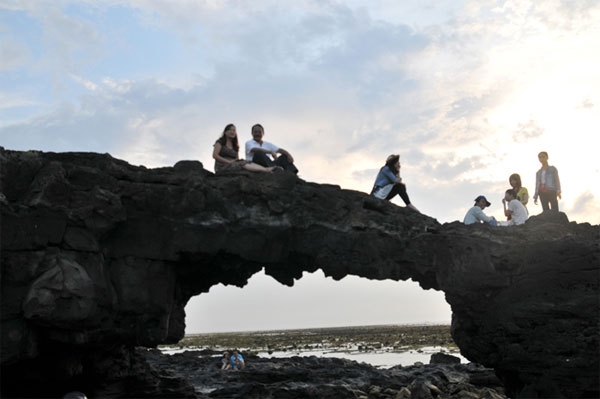Detecting the 'Archway Gate' at the bottom of Ly Son island sea
The group of divers and some archaeologists have discovered beautiful lava rock arch, located outside the coral reef close to the coast of An Binh commune, Ly Son island district.
According to the most likely assessment, this is a vestige from volcanic eruption activities millions of years ago, when lava encountered sea water frozen, creating a spectacular stone arch like the existing To Vo Gate on Ly Son Island.
Mr. Doan Xum, Director of Doan Anh Duong Company, said that after diving to survey the seabed at Be island (An Binh island commune), archaeologists and divers have discovered this stone arch has a bending shape. curvilinear shape and lasts about 20m. Calculated from the sea bottom, the dome where the highest about 5m.

The rocky cliffs and Archway Arches are formed by lava rock on Ly Son Island.
According to Mr. Xum, dozens of years of surveying many islands and seas across the country have never been done, but he and his divers have never seen such beautiful and beautiful stone arches.
"This is a rare natural masterpiece bestowed on Ly Son sea, stone arches identical to the ruins of the land-based Archway in the West Village, An Vinh Commune (Big Island) but the length and size of this stone arch. many times bigger , 'Mr. Xum said.
After watching the clip made by experts and divers on the seabed, Dr. Nguyen Dang Vu, Director of Quang Ngai Department of Culture, Sports and Tourism said that the discovery of giant stone arch is a great opportunity. to Ly Son to develop eco-tourism in association with diving, exploring the ocean.
'Ly Son has a wild and interesting beauty, including traces of Thoi Loi and Gieng Tien volcanic basins and cave systems, cliffs formed from volcanic lava both onshore and underwater forming chains. rare natural heritage. This stone arch will be preserved to serve tourism development of Ly Son island waters, " Vu affirmed.
On a recent survey, divers have discovered two ancient ships carrying ceramics and wrecked construction materials in the vicinity of An Binh commune. Initially, archaeologists said that these pottery and sandstone artifacts used to build the ancient Champa temple temple date from XV to XVI.
'Ly Son Island was formed due to the remnants of volcanic eruption from 250 to 300 million years ago. In addition to natural and onshore aquatic heritage, Ly Son island waters have a rich ecosystem of 700 flora and fauna species with nearly 140 seaweed species, 160 species of coral, more than 300 species of reef fish, 100 species of armor. corpses and a number of other species are rich and diverse in species, ' Dr. Vu said.
- Detecting many ancient craters under Ly Son sea bottom
- The Azure Window stone archway in Malta collapses into the sea
- Azure Window stone arches before collapsing into the sea
- Close-up of the new island formed on the Red Sea
- Detecting signs of life in the bottom of the Antarctic lake
- The earthquake in Sumatra island signaled the Indian Ocean's bottom fault
- Steam Cleaning - technology used to clean Ngo Mon Gate of Hue Citadel
- Detecting sharks 'ghosts' at the bottom of the sea
- Electronic gate helps to identify faces accurately
- New video filmed the fearsome 'hell gate' for 50 years
- Detecting pyramids of aliens on the seabed?
- After more than 2,000 years, the mystery of the hell gate was opened
 Discovered an ancient centipede fossil 99 million years old
Discovered an ancient centipede fossil 99 million years old Discovered bat-like dinosaurs in China
Discovered bat-like dinosaurs in China Discovered a 200-year-old bronze cannon of the coast
Discovered a 200-year-old bronze cannon of the coast Discover 305 million-year-old spider fossils
Discover 305 million-year-old spider fossils